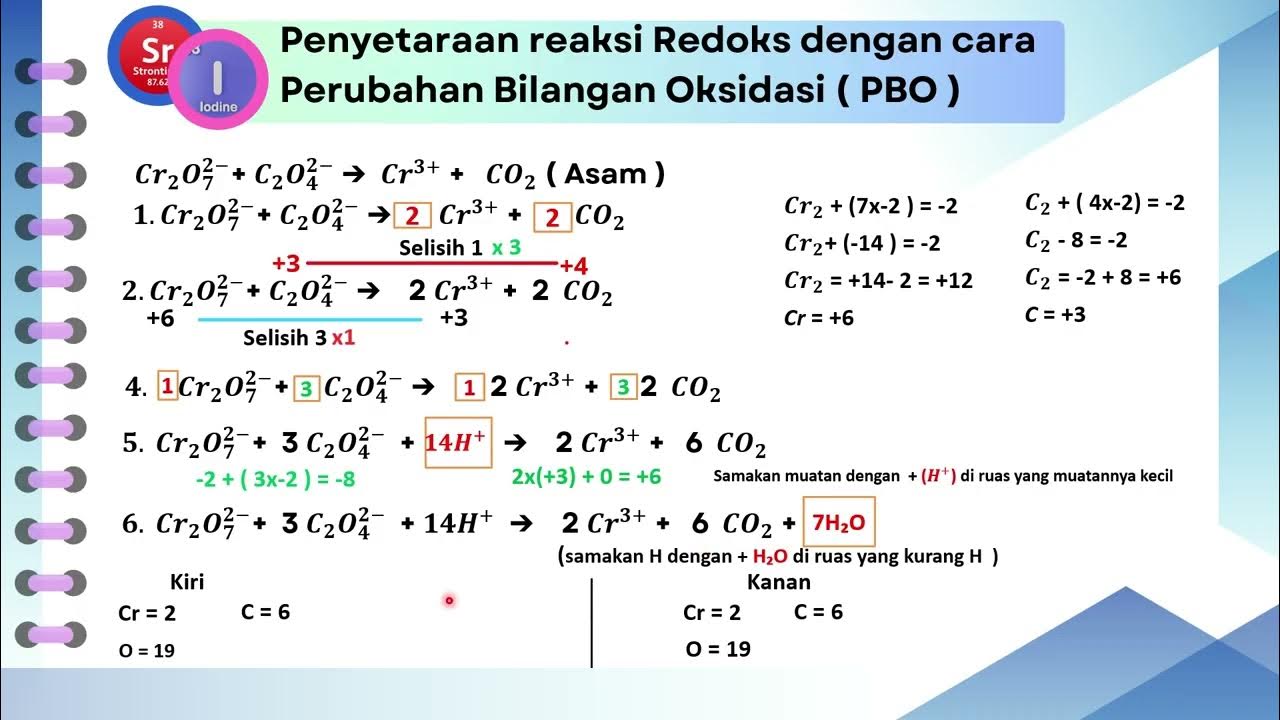Module 2 - Balancing Redox - Oxidation Number Method - 1
Summary
TLDRThe video script discusses balancing redox reactions, emphasizing the importance of considering charges on atoms and substances. It outlines two methods for balancing: the oxidation number method and the half-reaction method. The script provides a detailed step-by-step guide on how to balance redox equations, including assigning oxidation numbers, identifying oxidation and reduction, determining changes in oxidation numbers, balancing electrons, atoms, and charges. An example is used to illustrate the process, showing how to balance a reaction involving iron and permanganate ions.
Takeaways
- 🔬 Balancing redox reactions involves considering the charges of atoms or substances, which is different from balancing neutral equations.
- 🌐 The law of conservation of mass must be obeyed, along with balancing the number of elements and electrons in the reaction.
- 📐 There are two methods for balancing redox equations: the oxidation number method and the half-reaction method.
- 📖 The oxidation number method tracks changes in oxidation numbers of elements involved in the reaction.
- 📝 Assign oxidation numbers to each atom in the equation as the first step in balancing redox equations.
- 🔍 Identify which substances undergo oxidation and reduction by observing changes in oxidation numbers.
- 🔄 Determine the changes in oxidation numbers for elements involved in the reaction.
- ⚖️ Balance the electrons by adjusting coefficients to ensure the number of electrons lost is equal to the number gained.
- 🌐 Balance the atoms and charges by adjusting coefficients and possibly adding substances like water to the reaction.
- 💧 Adding water to a reaction can help balance the number of oxygen and hydrogen atoms.
- 🔋 Ensure that both the number of atoms and the total charges are balanced in the final equation.
Q & A
Why is it important to consider charges when balancing redox reactions?
-Charges are important in redox reactions because they indicate the transfer of electrons, which is the essence of redox processes. Balancing charges ensures that the law of conservation of charge is upheld, meaning the total charge on both sides of the reaction must be equal.
What are the two methods mentioned for balancing redox reactions?
-The two methods for balancing redox reactions are the oxidation number method (also known as the oxidation statement method) and the half-reaction method (also known as the ion-electron method).
How does the oxidation number method work?
-The oxidation number method works by tracking changes in the oxidation numbers of the elements involved in the reaction. It involves assigning oxidation numbers to each atom, identifying substances undergoing oxidation and reduction, determining the change in oxidation numbers, and then balancing the electrons and atoms.
What is the first step in balancing a redox reaction using the oxidation number method?
-The first step in balancing a redox reaction using the oxidation number method is to assign oxidation numbers to each atom in the equation.
How do you identify which substance undergoes oxidation and which undergoes reduction?
-You identify oxidation and reduction by observing changes in oxidation numbers. A substance that loses electrons (becomes more positive) undergoes oxidation, while a substance that gains electrons (becomes less positive) undergoes reduction.
What does it mean for a substance to be the oxidizing agent or the reducing agent?
-A substance is the oxidizing agent if it causes another substance to be oxidized (loses electrons). Conversely, a substance is the reducing agent if it causes another substance to be reduced (gains electrons).
How do you balance the number of electrons in a redox reaction?
-To balance the number of electrons, you equalize the total increase in oxidation numbers with the total decrease. This is done by adjusting the coefficients of the reactants and products to ensure the number of electrons lost by the oxidized substance equals the number gained by the reduced substance.
Why is it necessary to balance atoms and charges after balancing the electrons?
-After balancing the electrons, it's necessary to balance atoms and charges to ensure that the law of conservation of mass is upheld. This involves adjusting coefficients and possibly adding substances like water to balance the number of atoms and ensure that the total charge on both sides of the equation is equal.
What role does water play in balancing redox reactions?
-Water can be added to a redox reaction to balance the number of oxygen and hydrogen atoms. It also helps in balancing the charges by providing additional protons (H+) or hydroxide ions (OH-) as needed.
Can you provide an example of how to balance a redox reaction involving iron and permanganate ions?
-In the given script, iron (Fe) goes from an oxidation state of +2 to +3, and manganese (Mn) goes from +7 to +2. The changes in oxidation numbers are +1 for iron and +5 for manganese. By balancing the electrons, the coefficients for iron and manganese are adjusted to 5 and 1, respectively. Then, water is added to balance the oxygen atoms, and additional hydrogen ions are added to balance the charges, resulting in a balanced redox reaction.
Outlines

This section is available to paid users only. Please upgrade to access this part.
Upgrade NowMindmap

This section is available to paid users only. Please upgrade to access this part.
Upgrade NowKeywords

This section is available to paid users only. Please upgrade to access this part.
Upgrade NowHighlights

This section is available to paid users only. Please upgrade to access this part.
Upgrade NowTranscripts

This section is available to paid users only. Please upgrade to access this part.
Upgrade NowBrowse More Related Video

Penyetaraan Reaksi Redoks Metode Bilangan Oksidasi | Kimia SMA | Tetty Afianti

PENYETARAAN REAKSI REDOKS

PENYETARAAN REAKSI REDOKS REAKSI REDOKS CARA BILANGAN OKSIDASI

19.2 Balancing Redox Equations

Half Reaction Method, Balancing Redox Reactions In Basic & Acidic Solution, Chemistry

Persamaan reaksi redoks
5.0 / 5 (0 votes)